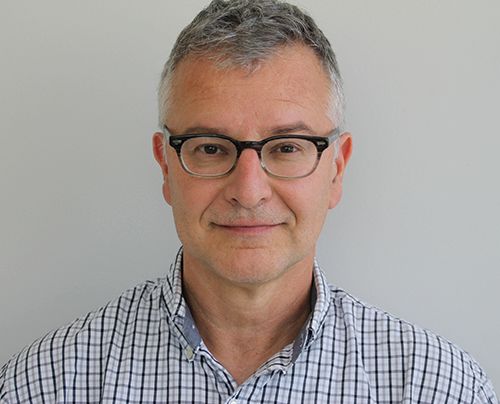John Manak ’84
 DEGREES:
DEGREES:
B.S. in biology; Ph.D. in molecular biology/biochemistry, Columbia University; postdoctoral work, Stanford University School of Medicine
JOB TITLE:
Professor, Departments of Biology and Pediatrics, University of Iowa and U.I. Carver College of Medicine
FAVORITE TRINITY MEMORY:
I enjoyed being in a vibrant liberal arts setting that allowed me to obtain a world-class education across a variety of different disciplines. I really appreciated the breadth of my education. And I can’t forget playing guitar in rock bands on campus with fellow Trinity students, including at the Iron Pony Pub!
What has been your professional path?
After working for two biotech firms, it quickly became clear that I needed to get back to academia. I wanted to run my own lab. I was a unique candidate for academia because I had extensive experience in biotech with microarrays (a hot technology at the time), which allow you to look at gene expression across an entire genome. Once I was hired at the University of Iowa (2008), I was opportunistic in terms of what projects to work on. One was understanding the genetics of seizure disorders by developing a fruit fly model of epilepsy, and the other was identifying regions of the human genome that might be deleted or mutated in individuals with genetic disorders. Both projects really took off and became the focus of my laboratory.
Would you explain a bit more about your research?
I study human disease genetics. We have discovered new genes for a number of congenital anomalies, including renal agenesis, spina bifida, and orofacial clefting (also known as cleft lip and/or palate). We just published a study in The American Journal of Human Genetics about the identification of three new genes associated with orofacial clefting. We also have generated the first direct genetic proof that activation of the innate immune system in the brain is involved in epilepsy progression, and we just had a paper on this accepted for an upcoming issue of Cell Reports.
What do you enjoy most about doing research?
The excitement of discovery. When you are the first to work out a challenging biomedical problem. Nothing better!
What courses do you teach?
I teach three classes. “Fundamental Genetics,” which in my opinion is the underpinning of all of biology. In “Readings in Genetics,” we go over some of the classic papers in scientific literature. I developed the third course, “Good Genes Gone Bad: Genetic Disorders of Notable Celebrities,” which allows students with no biology or genetics background to learn about human disease genetics. In it, I teach a little about embryology and about what goes wrong when a particular gene is mutated. Ultimately, I show a video or interview with a celebrity who has that disorder. I’ve also found that the best way to reach students is to bring in individuals with genetic disorders to talk with the students and start a dialogue where students can ask questions about living with the disorder and the challenges they face. My goal is to make the next generation much more aware and sensitive to the needs of individuals with genetic disorders.
And what do you enjoy most about teaching?
When a student takes a genuine interest in the subject matter and you see that elusive spark in their eyes! If my courses influence students to go into biomedical careers, all the better.
What are the biggest challenges you face?
This is true for virtually anyone who engages in biomedical research: continuing to obtain substantial funding, to weather the periods when experiments aren’t working or aren’t yielding interesting results, and the overall time commitments necessary to continue publishing in top-tier journals.
What were the most memorable courses you took at Trinity?
Certainly, one of my favorite courses was “Creative Writing” with the late Hugh Ogden. Also, “Myth, Rite, and Sacrament” with Leslie Desmangles. I’m convinced that good scientists are creative people, and there’s a nice marriage between the left and right brain, so to speak. Your analytic side is heavily influenced by your creative and artistic side and vice versa. I think it’s important to develop both, as there’s a lot of cross-pollination. Trinity also gave me an opportunity to engage in research in biology. I really enjoyed, and learned a lot from, the biology classes that were taught; all of them were exceptional (in a good way!). I have fond memories of any biology course that was taught by the late James Van Stone. He was such a kind soul, and he gave me my first research opportunity in his laboratory. I even remember the project—studying amphibian limb regeneration in the red-spotted newt.
